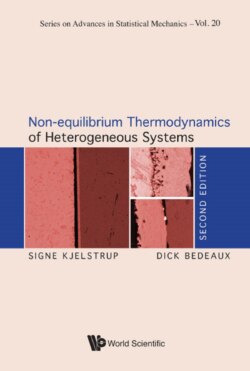Читать книгу Non-equilibrium Thermodynamics of Heterogeneous Systems - Signe Kjelstrup - Страница 34
4.4.1Definitions of frames of reference
ОглавлениеThe laboratory frame of reference or the wall frame of reference. The experimental apparatus is at rest in this frame of reference. We define the velocities of the various components in this frame of reference by
| (4.18) |
where cA is the concentration of A in mol/m3.
The flux of A (in mol/m2 s) in a frame of reference which is moving with a velocity vref relative to the laboratory is given by
| (4.19) |
The solvent frame of reference. This frame of the reference is typical when there is an excess of one component, the solvent. For transport of A relative to the solvent, one has
| (4.20) |
The frame of reference moves with the velocity of the solvent, vsolv.
The average molar frame of reference. In a multicomponent mixture, there is no excess of one component, and we use the average molar velocity:
| (4.21) |
Here, xj = cj /c is the mole fraction of component j. This gives as flux of A:
| (4.22) |
The average volume frame of reference is used when transport occurs in a closed volume. The average volume velocity is
| (4.23) |
where Vj is the molar volume of component j. The flux of A becomes
| (4.24) |
The barycentric (average center of mass) frame of reference. This frame of reference is used in the Navier–Stokes equation. The average mass velocity is
| (4.25) |
where ρ is the mass density of the fluid, and ρj are the partial mass densities. The flux of A in mol/m2s in the barycentric frame of reference is therefore
| (4.26) |
In the barycentric frame of reference, the dimension of the component fluxes used is normally kg/m2s [23]. The flux in kg/m2s is found by multiplication with MA, the molar mass, MAJA,bar ≡ ρA(vA − v). This is the diffusion flux of component A. The sum of these diffusion fluxes (in kg/m2s) over all neutral components is equal to zero.
Remark 4.2. In our analysis, we only consider electroneutral systems. The sum in Eq. (4.25) is therefore over neutral components. In charged systems, like those considered by de Groot and Mazur [23], the sum is over charged and uncharged components. For electroneutral systems, this results in an average mass velocity which differs from the one that we use, by a term proportional to the electric current density. We refer to the appendix at the end of this chapter for an example.
In this book, we consider heterogeneous systems. As will be explained in the following two sections, the excess entropy production of a surface and a three-phase contact line should be calculated in a frame of reference which moves along with the surface or the contact line. We refer to these as the surface frame of reference and the contact line frame of reference. For practical reasons, the same frame of reference is usually taken for fluxes in the adjacent homogeneous phases. As will be explained in Chapter 12 for multi-component diffusion, one can use Gibbs–Duhem’s equation to obtain flux–force relations, which are independent of the frame of reference. For each example considered in this book, we shall indicate which frame of reference is used and why.
